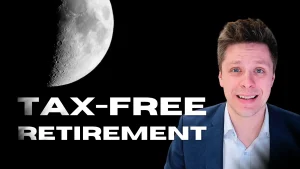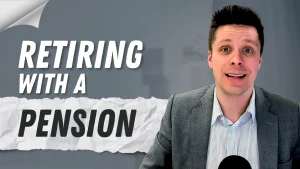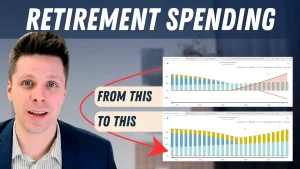[vc_row css=”.vc_custom_1612380408194{padding-top: 20px !important;padding-bottom: 20px !important;}”][vc_column][vc_video link=”https://youtu.be/I_3vUWzw4hg” css=”.vc_custom_1706125962708{padding-top: 20px !important;padding-bottom: 20px !important;}”][vc_column_text css=”.vc_custom_1706127224530{padding-top: 20px !important;padding-bottom: 20px !important;}”]There are three tax mistakes that every retiree should avoid.
In retirement, there are plenty of tax planning opportunities that can save you a significant amount of money.
In meeting with 100s of retirees every year, we see the same mistakes being made over and over again.
1st Mistake: No Plan
The first being is that there is no plan to tax-efficiently withdraw from the portfolio, which leads to significantly more taxes being paid than required.
Mr. & Mrs. Retirement had a portfolio made up primarily of RRSPs, with some money in TFSAs and a non-registered account. Their retirement portfolio amounted to just over $1 million dollars.
They wanted to be able to spend $6,500 per month, adjusted for inflation until they were both 90, but had no real plan to withdraw from their retirement portfolio.
Their current advisor had recommended that they not withdraw from their RRSPs, but instead use up their TFSAs and non-registered accounts first. This would keep their tax bill low today as they would be deferring the taxes on the RRSP withdrawals, but Mr & Mrs Retirement weren’t sure if this was the best approach.
After mapping out this scenario, Mr. and Mrs. Retirement were on track with their retirement plan being funded at a rate of 107%.
However, there was a red flag that Mr. and Mrs. Retirement were not aware of.
By planning to age 90, Mr. Retirement had a couple more years than Mrs. Retirement. When he was 90, there was still $886,000 remaining in his registered account, which was now a RRIF.
The issue with having so much money left in a registered account is that the entire amount is taxed in the year of death.
After accounting for taxes, Mr. Retirement’s estate was valued at $403,000. Over 50% of his RRIF disappeared to taxes!
By implementing a tax-efficient withdrawal plan, we could improve this outcome dramatically.
We targeted a taxable income of $41,000 per year for both of them. To reach this taxable amount, we would start drawing on their RRSPs much sooner into retirement.
By implementing this strategy, their TFSAs would continue growing tax-free over time, and their RRSPs would be used up prior to Mr. Retirement passing away. By making this one change, their plan outlooked increased to 113%, and their estate was almost $400,000 more.
Having a withdrawal plan in place can save you thousands, if not hundreds of thousands in taxes throughout your retirement.
A Personalized Approach to Retirement Planning
If you would like help with your retirement withdrawal strategy in retirement, complete our retirement withdrawal questionnaire.
It takes five minutes to complete, and I will send you your very own personalized video with some withdrawal strategies.
2nd Mistake: Misusing Your TFSAs
Tax-Free Savings Accounts are an incredible tool to use in retirement but are often misused, resulting in missed opportunities.
Although it’s called a Tax-Free Savings Account, you don’t have to leave your contributions in a savings account. You can invest the funds within the account in stocks, bonds, ETFs, and mutual funds, providing you with additional long-term growth opportunities.
The primary benefit of the TFSA is that any income, growth, or dividends generated in the account are yours to keep without having to pay tax.
Generally speaking, retirees will have saved for their retirement through various accounts. Accounts such as pensions, RRSPs, TFSAs, and non-registered accounts.
For many retirees like Mr. & Mrs. Retirement that we saw in our last example, it often makes sense to pull from their registered and taxable accounts before accessing their TFSA.
Since their TFSAs won’t be needed to fund their retirement immediately, Mr. & Mrs. Retirement can afford to be more aggressive with the investments they choose in their TFSAs.
So, rather than using the TFSA as an emergency fund in retirement, it often makes sense to be more aggressive with this account as all the growth will be tax-free, whereas if you are more aggressive in an RRSP, for example, all of that growth will be taxed once withdrawn.
3rd Mistake: Unaware of Annual Income
The third mistake we see retirees make is being unaware of their annual income.
This could lead to missed benefits in retirement, and to counteract this, we are going to do the opposite of mistakes 1 & 2.
Jim was single and retired at 65 with a million dollars in his portfolio. The majority of that was in his RRSP with a TFSA valued at $150,000.
Jim was receiving CPP and OAS and lived a fairly frugal life. He figured he would have to withdraw $30,000 from his portfolio to provide him with the cash flow he needed.
If he wanted $30,000 from his RRSP, he would need to withdraw about $43,000 to account for a withholding tax of 30%. The $43,000 would be added to his taxable income for the year.
On the other hand, if he withdrew $30,000 from his TFSA, there would be no tax and it wouldn’t be added to his taxable income for the year.
This would keep Jim’s income as low as possible, and he could qualify for the Guaranteed Income Supplement. This is an additional benefit that you can receive in addition to OAS if you have a low income.
Based on Jim’s current income from CPP and OAS, he would be eligible for a GIS benefit of $607 per month if he kept his income low by using his TFSA.
That’s over $7,000 per year!
If Jim kept doing this for 5 years until his TFSA was used up, he would have received over $35k from GIS.
There are a lot of variables that come into play when putting together a tax plan in retirement.
One person’s mistake may be another person’s opportunity.[/vc_column_text][/vc_column][/vc_row]





